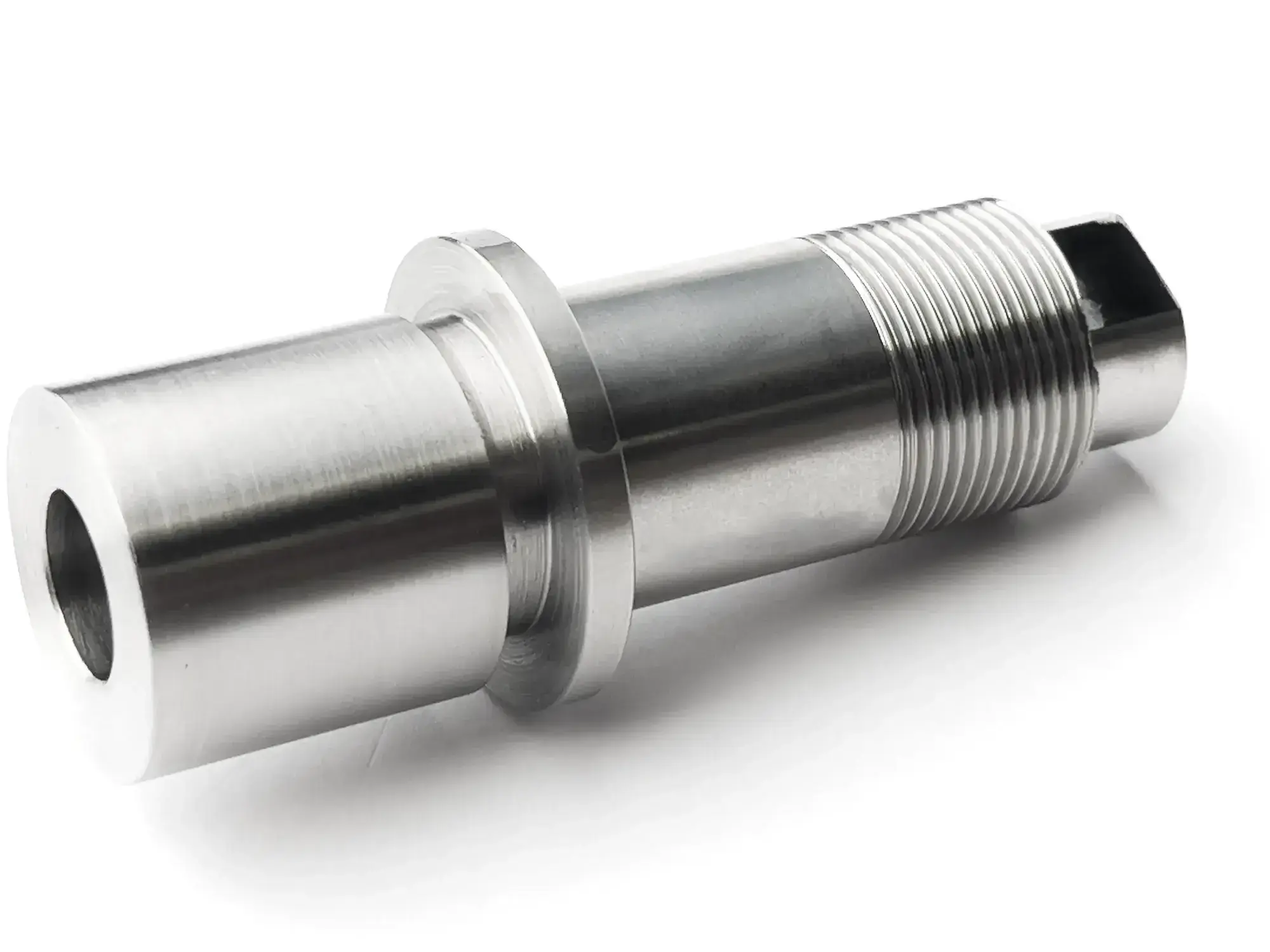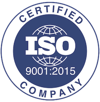STAINLESS STEEL 303
Explore the cost-effective and production-friendly Stainless Steel 303: the perfect choice for corrosion-resistant parts.

PROS
- Cost-effective compared to other stainless steels
- Ideal for mass production
- Corrosion-resistant
CONS
- Limited to turning operations
- Less corrosion resistance compared to 316L and 304
- Lower weldability than other stainless steels
MAIN FEATURES
- Machining process: CNC Machining
- Tolerances: ISO 2768-1 fine (f) or medium (m) class. Info
- Max size: 64x64x150 mm (2.5x2.5x5.9 in)
- Lead time: <6 days
STAINLESS STEEL 303 CNC MACHINING VIDEO GALLERY
Cost-Effectiveness
Stainless Steel 303 is appreciated for its affordability. Its machinability reduces production time and costs, making it a smart choice for budget-conscious projects without sacrificing quality. It is an affordable option that balances performance and price, ideal for keeping production costs under control.
Ideal for Mass Production
Stainless Steel 303 excels in mass production. Its easy machinability allows for rapid, consistent output, benefiting from economies of scale. This translates to lower per-unit costs and a more affordable end product, crucial for competitive manufacturing markets.
Corrosion Resistance
Though Stainless Steel 303 offers less corrosion resistance than grades 316L or 304, it provides sufficient protection for many everyday applications. It's a viable choice where severe corrosion is not a concern, offering a balanced compromise between durability and cost.
IMAGE GALLERY
QUOTE NOW YOUR PARTS
free instant quoteCOMMENT
Stainless Steel 303 is a free-machining grade of austenitic stainless steel, specifically designed for machining operations. It maintains good mechanical and corrosion resistance properties, making it a suitable choice for parts that are extensively machined in high volume production. Despite its lower corrosion resistance compared to grades like 316L and 304, and its limited weldability, its cost-effectiveness and machinability make it a popular choice for specific applications.
Pros
• Cost-Effectiveness
Stainless Steel 303 offers a lower cost compared to other stainless steel grades, which can be a significant advantage when budget constraints are a priority.
• Suitability for Mass Production
Due to its excellent machinability, Stainless Steel 303 is particularly well-suited for high-volume production runs, making it a cost-effective choice for the mass production of parts.
• Corrosion Resistance
While not as resistant as 316L or 304, Stainless Steel 303 still offers good corrosion resistance, which is sufficient for many applications.
Cons
• Limited Availability for Machining Processes
Stainless Steel 303 is available primarily for turning operations, which may limit its use in other types of machining processes.
• Lower Corrosion Resistance
Compared to 316L and 304 stainless steel grades, 303 has a lower resistance to corrosion, which may restrict its use in more aggressive environments.
• Weldability
The weldability of 303 stainless steel is lower than that of other stainless steels, which can be a disadvantage for applications requiring welding.
Applications
Versatile Use in Mechanical Components: Stainless Steel 303 has carved out a niche in the manufacturing sector as the material of choice for a multitude of mechanical components. Its remarkable machinability makes it ideal for creating precise and intricate parts like pins and bushings. These components often serve as critical pivot points or alignment features in machinery, where smooth operation and dimensional stability are paramount.
Fasteners and Fittings: The alloy composition lends itself well to the production of industrial fasteners, including screws and nuts. These fasteners benefit from the inherent strength of steel and its ability to resist wear and seizure, which is particularly important in applications where they are frequently adjusted or removed. The ease with which Stainless Steel 303 can be machined allows for the mass production of these items with consistent quality and tight tolerances.
Structural Integrity for Rods and Tensioners: Rods and tensioners made from Stainless Steel 303 are often found in automotive and architectural applications. In the automotive sector, they contribute to the structural integrity of vehicles, acting as support and adjustment mechanisms in seats, engines, and suspension systems. In architecture, tensioners made of this steel are used in structural cable systems, providing both aesthetic appeal and functional stability.
Adaptability for Custom Parts: Steel adaptability is a blessing for custom fabrication, where it is used to create custom parts tailored to specific applications. This includes specialised tooling and prototypes that benefit from the steel's easy machining and reliable performance.
Durability in Everyday Products: In addition to industrial applications, 303 stainless steel is also used in the production of consumer goods such as kitchen appliances, sports equipment and electronic devices. Its resistance to corrosion, coupled with a pleasing aesthetic finish, makes it a suitable choice for items that are handled frequently and are exposed to a variety of environments.
A Material for Non-Critical Corrosive Conditions: While it is not the top contender for extreme corrosive environments, Stainless Steel 303 holds its own in conditions where corrosion is a concern but not predominant. This makes it a cost-effective alternative for parts that require corrosion resistance without the necessity for the higher performance of more expensive grades like 304 or 316L.
Comparison with Other Materials
304 Stainless Steel
Cost-Effectiveness: 303 stainless steel is more cost-effective than 304, making it a budget-friendly option for large-scale production.
Machinability: 303 is preferred for its superior machinability, allowing for easier and faster production of components.
Corrosion Resistance: While 304 has better corrosion resistance, 303 still offers adequate protection for many applications, balancing cost and performance.
316 Stainless Steel
Cost-Effectiveness: 303 stainless steel stands out for its cost savings, particularly in less corrosive environments where the higher resistance of 316 is not required.
Machinability: The machining of 303 is more straightforward than 316, contributing to lower production costs and time.
Application Specificity: 303 is ideal for parts that do not require the high corrosion resistance of 316, such as indoor applications or less aggressive environments.
S355J2 Steel
Cost-Effectiveness: 303 stainless steel offers a more economical choice for applications where the higher strength of S355J2 is not necessary.
Corrosion Resistance: Unlike S355J2, 303 does not require additional protective treatments for corrosion resistance, reducing overall material costs.
Machinability: 303 excellent machinability over S355J2 makes it the preferred choice for complex parts requiring precision machining.
11SMnPb37 Steel
Cost-Effectiveness: 303 stainless steel is generally cheaper than 11SMnPb37, especially when considering the stainless feature that reduces the need for protective finishing.
Machinability: While 11SMnPb37 is known for its excellent machinability, 303 also offers exceptional and comparable machinability, which is crucial for reducing manufacturing time.
Corrosion Resistance: 303 outperforms 11SMnPb37 in corrosion resistance, providing a significant advantage in environments where moisture or mild corrosive conditions are present.
Conclusions
Its limitations in terms of weldability and availability only for turning processes should be considered when selecting this material for specific applications. Nevertheless, for parts that require extensive machining and do not face extreme corrosive conditions, Stainless Steel 303 is an excellent choice that balances performance with cost.
Lastly, the decision to use Stainless Steel 303 should be based on a thorough evaluation of the specific requirements of the application, considering both the advantages and limitations of the material.
"I frequently engage in material selection, and Stainless Steel 303 has become my go-to for batch production. Its machinability is outstanding, cutting down production times without compromising quality. Although it is less resistant to corrosion than other grades, its performance is more than sufficient for non-critical applications. Moreover, the cost-performance ratio is unbeatable. I highly recommend it for those seeking efficiency and reliability"
PROPERTIES
| Tensile breaking load | 550 MPa |
| Modulus of elasticity | 200 GPa |
| Elongation at break | 25 % |
| Density | 7,9 g/cm³ |
| Hardness | 225 HB |
| Yield strength | 190 MPa |
Questions and answers
303 stainless steel is generally considered non-magnetic because of its austenitic structure. However, slight magnetism can be introduced during cold working or machining processes. This magnetic property is typically minimal and does not affect its overall classification as a non-magnetic material in most practical applications.
303 stainless steel is an austenitic stainless steel alloy specifically designed for enhanced machinability. The addition of sulfur in its composition improves its cutting performance, making it one of the most machinable stainless steel grades. It provides moderate corrosion resistance, good mechanical strength, and excellent toughness. While it excels in machining, its resistance to corrosion is lower than that of some other stainless steel grades, such as 304 or 316. This makes 303 more suitable for components in environments where corrosion is not critical.
Yes, 303 stainless steel is classified as an austenitic stainless steel. Its composition includes high levels of chromium and nickel, which ensure the austenitic structure. This structure provides good toughness, moderate corrosion resistance, and non-magnetic properties in its annealed condition. The sulfur addition enhances machinability but slightly reduces corrosion resistance compared to other austenitic grades.
303 stainless steel is widely used for applications requiring high precision and excellent machinability. Common uses include pins, bushings, screws, nuts, turnbuckles, and other mechanical components. It is especially suitable for parts not exposed to highly corrosive environments. Its moderate corrosion resistance and ability to achieve tight tolerances make it a popular choice for industrial hardware, automotive components, and machined parts.
The primary difference between 303 and 304 stainless steel lies in their machinability and corrosion resistance. 303 stainless steel is specifically optimized for machining due to the addition of sulfur, which makes it easier to cut and shape. However, this sulfur content reduces its corrosion resistance compared to 304 stainless steel. In contrast, 304 stainless steel offers better resistance to corrosion and is commonly used in environments with higher exposure to moisture or chemicals. While 303 is ideal for precision-machined parts, 304 is preferred for applications where superior corrosion resistance is required, such as in food processing or chemical containers.
303 and 316 stainless steel differ primarily in their corrosion resistance and machinability. 316 stainless steel contains molybdenum, which greatly enhances its resistance to corrosion, particularly in marine or chloride-rich environments. In contrast, 303 does not contain molybdenum and is less resistant to aggressive conditions. However, 303 is easier to machine due to its sulfur content, making it more suitable for manufacturing parts requiring high precision and efficiency. While 316 stainless steel is ideal for harsh environments and demanding applications, such as marine hardware and chemical processing, 303 excels in situations where machinability is the priority, such as producing screws, bolts, and bushings.
QUOTE IN 1 SECOND WITHOUT COMMITMENT
DON'T WAIT: UPLOAD YOUR 3D FILE AND GET A QUOTE FOR YOUR PARTS NOW!
Upload your 3D file to get one step closer to manufacturing your parts.
free instant quote



